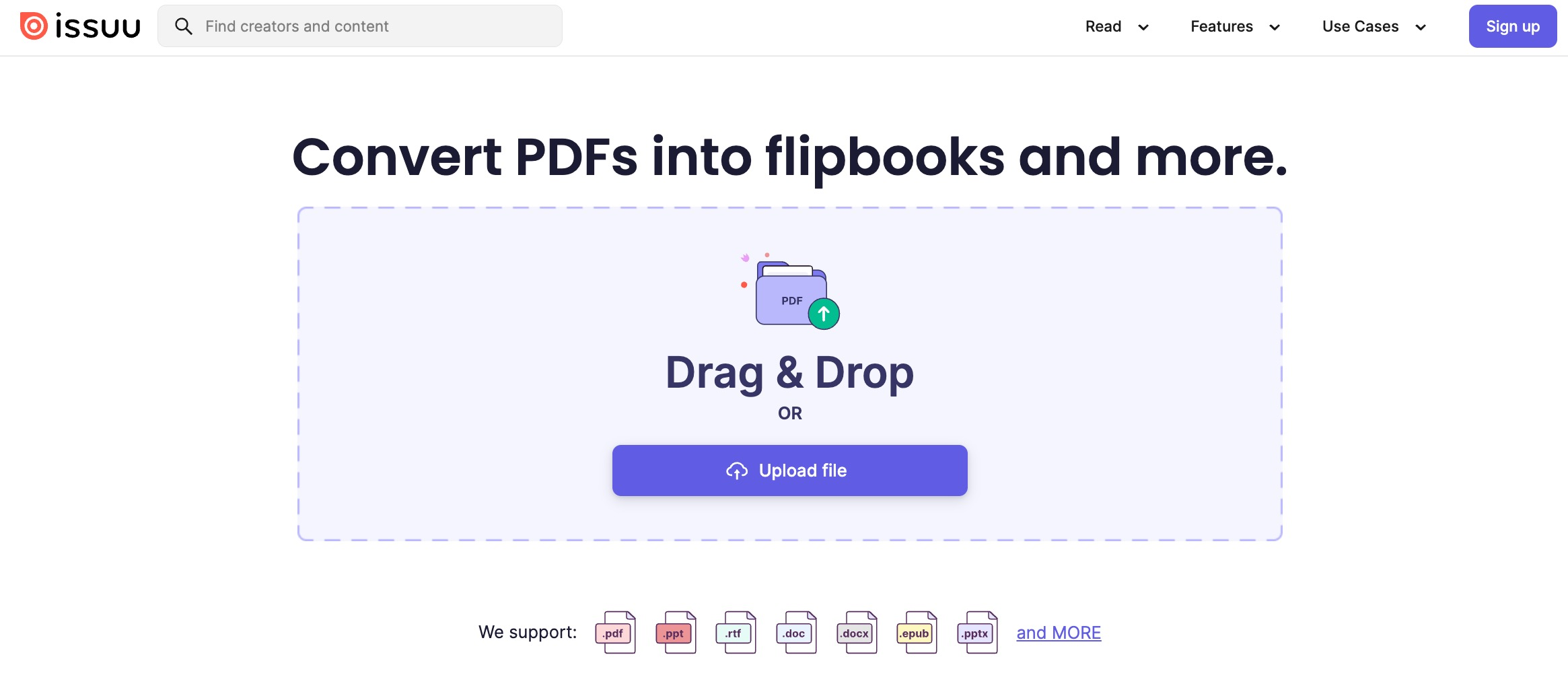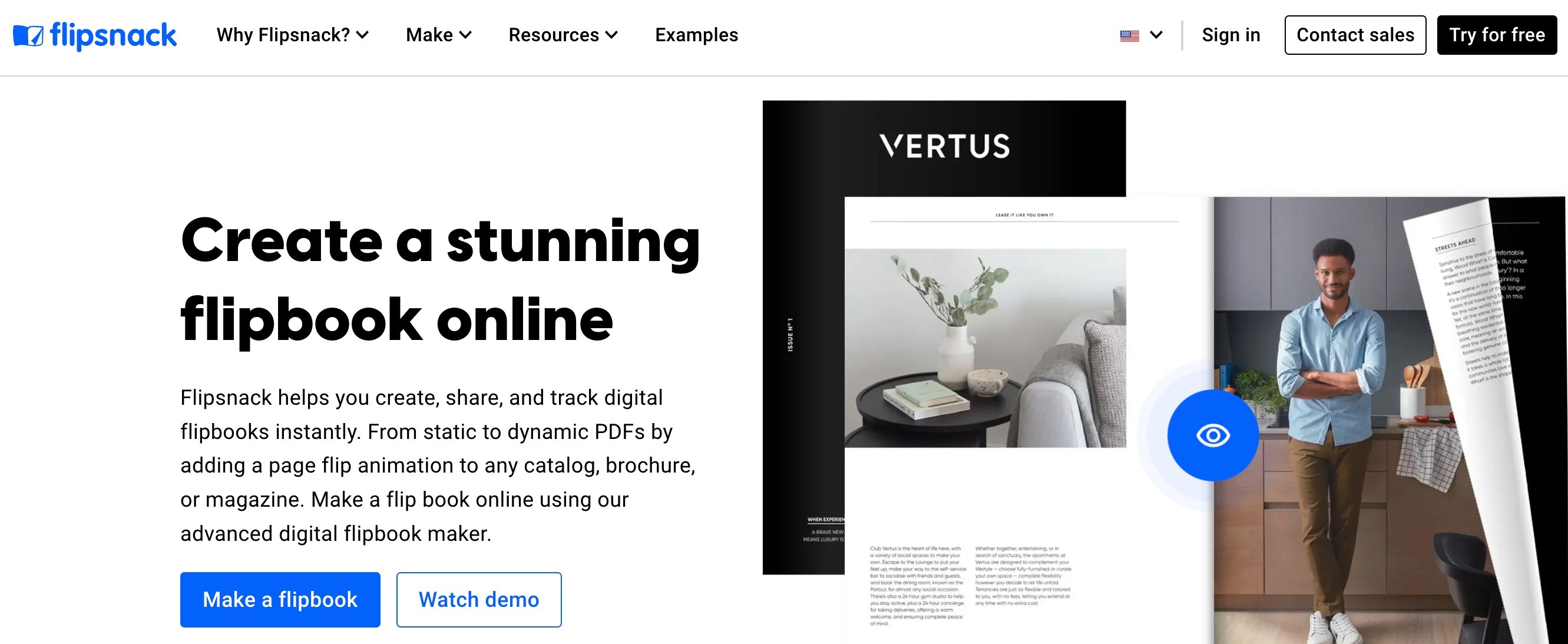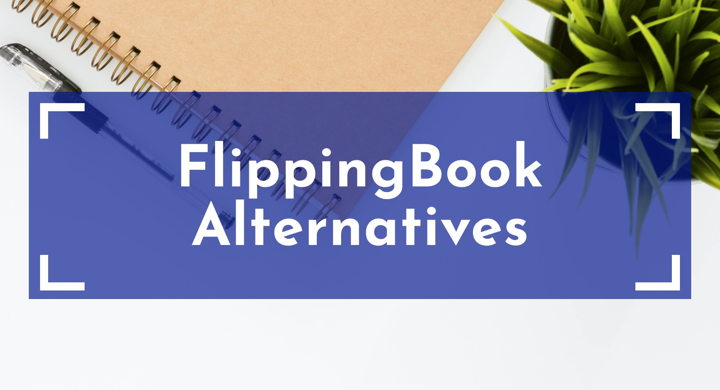Looking for the perfect flipbook maker to meet your company's needs? While FlippingBook works tirelessly to provide a well-rounded product that's both powerful and easy to use, we recognize that one size may not fit all in the world of digital document publishing. Every business operates differently—and you may have distinct requirements that demand certain product features. That's why we are here to guide you through them all: with a comprehensive overview of FlippingBook's alternatives, their strengths, limitations, and cost-effectiveness.
- Issuu would be the go-to solution for companies and individuals looking to publish and monetize digital content, particularly subscription-based magazines.
- Canva is primarily a tool for design tasks, but you can use it to create, share, and print PDF newsletters, reports, brochures, and presentations.
- Flipsnack lets you make flipbooks from scratch and supports advanced ecommerce features like shopping automation for retail marketers.
- FlipHTML5 works with a variety of file formats and provides templates, free and paid, for most document types—with lots of branding options on top.
- Relayto focuses on so-called digital experiences, the flipbook format among them, that you can enrich with interactivity and share or embed on the web.

What is FlippingBook?
FlippingBook for Your Digital Documents
With FlippingBook, you can:
- Share your PDF online within minutes as a direct link.
- Match your business image by branding catalogs, magazines, or brochures, and make them an integral part of your website with a simple embed.
- Keep viewers engaged throughout the entire flipbook by adding interactive elements such as pop-ups, image galleries, GIFs, videos, and quizzes.
- Get to know your readers better by analyzing stats on how they interact with your content, what devices they use, and where they come from.
- Reach new audiences online with public links and an SEO boost, or share your flipbook offline via a QR code.
- Have instant access to up-to-date content and one-click sharing on your smartphone in the mobile app.
- Follow up with clients or partners at the right moment—send trackable links and receive push notifications when they open your document.
- Make multi-chaptered PDFs of up to 2,000 pages a breeze to navigate with internal links and a built-in table of contents maker.
- Confidently share internal or sensitive documents with guaranteed privacy and security, or self-host flipbooks on your own server.
- Generate leads with a customizable lead capture form, pass them right to your CRM, and automate other workflows with Zapier integration.
FlippingBook is valued for its customer service and intuitive interface, which puts us among the leaders in the Flipbook software category on G2. After 20 years in business, we've happy to help 65,000+ clients spanning across all industries, from hospitality to real estate, consulting, and insurance. As for pricing, it starts from $26/month, and you can try almost all of the features for free for two weeks.
Now let's see how FlippingBook compares to similar solutions on the market.

#1 Issuu

Issuu is a publishing platform that transforms PDFs and other file formats into shareable flipbooks, articles, and GIFs. Besides being an online converter, Issuu is very similar to a social media outlet. Most documents are public, creators can set up their own profile, while readers may use keywords to search for specific content or browse through ads and recommendations. If you're looking to build a following, expand your subscriber base, and make a profit out of it, Issuu is worth a try. Check out Issuu alternatives if you're interested in other features.
🔑 Key differences from FlippingBook:
- Monetization. Issuu offers several ways to generate revenue: paid ad space, affiliate links, shoppable pages, and a built-in ecommerce tool that facilitates access to single issues or ongoing subscriptions through Stripe payments.
- Reusable content. With the Articles feature, you can automatically generate mobile-optimized web pages from your chosen flipbook sections, and repurpose text and images across different channels. The same goes for Social Posts.
- Scheduled publishing. For those following a content calendar, Issuu has features to schedule or backdate publications.
⛔ Drawbacks:
- A lack of privacy. You'll only have an unlimited number of private flipbooks on the most expensive plan—so choosing Issuu makes more sense if you want your content to be public.
- Limited interactivity. You can add GIFs and videos, but that's it: no image galleries, quizzes, pop-ups, or other interactive elements. Flipbooks made with Issuu don't have book shadows or volume—so the reading experience is not really life-like aside from the standard page flip.
- Third-party ads. Unless you're on the Premium plan and higher, your readers will see ads and suggestions promoting other businesses around your content.
💰 Pricing: The Basic plan is free, paid plans start from $31/month.

#2 Canva

While Canva is not a dedicated flipbook maker, you can use it to share PDF files—as a direct link with access permissions to view, comment, or edit in Canva's interface. Design-wise, the tool is very versatile and offers thousands of templates for every need, as well as an extensive library of stock photos, videos, diagrams, stickers, and shapes—both free and paid. Canva also has printing services for posters, invitations, and other physical products if that's something you would be interested in.
🔑 Key differences from FlippingBook:
- Template library. You can make a design from scratch or browse the multitude of templates Canva has for different styles, dimensions, and use cases.
- Export formats. Canva doesn't export PDFs as digital page flip documents, but has a seamless integration with FlippingBook if you wish to turn your designs into online flipbooks. You can also download files as PPTX, GIFs, MP4 videos, and images in high or standard quality.
- AI for content creation. A set of AI features called Magic Studio lets you craft presentations, videos, or social posts, reformat images, and edit visuals through prompts or simple drag-and-drop.
⛔ Drawbacks:
- No document analytics. You can't track basic opens or views, let alone advanced statistics like geolocation, devices, engagement, or time spent on each page.
- Limited sharing. Canva doesn't have any content protection options, and you can't add your custom domain for branded links. Tracked sharing with open notifications is also not available.
- No lead capture. Canva's design capabilities are, no doubt, impressive, but the tool won't be an aid for lead generation or other common marketing tasks.
💰 Pricing: $13/month for the Pro plan, the free version is open to everyone.

#3 Flipsnack

Flipsnack is a popular flipbook maker launched in 2011, made for creating digital guides, brochures, presentations, portfolios, and other page flip publications. In terms of interactivity, the tool supports audio and video, photo slideshows, data charts, product tags, and iframe embeds (only in the highest plan). As for statistics, you can track views, impressions, downloads, and clicks for individual documents or all of them combined.
🔑 Key differences from FlippingBook:
- Design studio. If you don't have a PDF on hand, Flipsnack has a simple image editor and a selection of styles and fonts to help you create a document layout.
- More features for teamwork. Teams on the Enterprise plan can assign standard user roles, view activity logs, and leave internal comments to collaborate on flipbooks.
- Shopping automation. You can let customers assemble wishlists and submit orders, or link your data source with Flipsnack to automate price changes.
⛔ Drawbacks:
- Design limitations. Flipsnack's editor is good, but not as powerful as dedicated graphic design tools. And it only works for flipbooks created in Flipsnack—so you won't be able to update a typo or change your PDF content in the same interface.
- Text quality. Flipsnack has no vector text support, unless it is added through their editor. So the tool doesn't recognize your PDF text, which means it's not selectable, won't show up in search results, and may have lower quality when zoomed in.
- Limited trial. During the trial, your flipbooks are limited to a maximum of four pages—the rest won't be displayed during sharing, which might not be enough to assess how your clients or partners will respond to the new content format.
💰 Pricing: Free 14-day trial, $32/month for the most basic package, from $48/month for higher plans.
💡 Want to learn about Flipsnack alternatives?
Check out the reasons why brands choose FlippingBook over Flipsnack.

#4 FlipHTML5

FlipHTML5 covers various digital document needs, such as content distribution, brand awareness, and monetization. You can, for instance, share your publications as website embeds or social media previews, apply customization options, and display ads in your flipbooks with a Google AdSense integration. The converter works with PDF, PPT, Word, and JPG files, and turns them into mobile-friendly flipbooks.
🔑 Key differences from FlippingBook:
- Brand kit. With FlipHTML5, you may upload your own font and pick a certain color scheme to have the content match your media kit perfectly.
- Templates. You can choose from an extensive template library sorted by document types: from guidebooks to photo albums, portfolios, and newsletters. Most of them are available for Enterprise users only, though.
- Digital sales. FlipHTML5 integrates with Stripe to process payments from your readers, be it subscription fees for digital magazines or custom designs.
⛔ Drawbacks:
- No trial. FlipHTML5 does have a free plan, but you can't test any of the premium features like interactivity or advanced flipbook statistics unless you commit to a paid subscription.
- Steep learning curve. The tool's interface is rather complicated, with lots of menu settings taking over a large chunk of your screen. There are no visible cues that certain features are above your current plan, so you constantly encounter a banner asking you to upgrade, which can be annoying.
- Limited downloads. The number of downloads on lower plans is strictly limited, which may be a nuisance if your clients or partners wish to download your publications.
💰 Pricing: Paid plans start from $15/month, the lowest plan is forever-free.

#5 Relayto

Relayto is an unconventional FlippingBook alternative since it's not exactly a flipbook maker, rather, a content experience platform that happens to convert PDFs into HTML5 web pages. To enhance your documents, you can add background videos, animations, CTA buttons, and stickers, or embed third-party lead capture forms. All paid plans come with private sharing options, like password protection or an email gate.
🔑 Key differences from FlippingBook:
- AI Content Chat. A built-in bot can assess and summarize the content in your documents, and use natural language processing algorithms to chat with your readers, answer questions, or find relevant pages for their query.
- More integrations. Higher plans support an integration with HubSpot, Salesforce, Marketo, and a couple of common data analytics tools. With FlippingBook, though, you can still access all of these apps—and more—via Zapier integration.
- Multi-view. Viewers can choose from a number of page flip options and decide whether they want to browse your document as a carousel, pageless scroll, slideshow, etc.
⛔ Drawbacks:
- Performance speed. Flipbooks, especially those heavy with interactive elements, take a very long time to load. Your customers might just not have the patience to wait the extra minute.
- No branding options. You can't add your business logo, change the favicon, or set a custom background, except for AI video.
- Price. Relayto offers several other digital experiences besides flipbooks, and if you're only looking for a platform for your digital documents, the price is rather steep.
💰 Pricing: Relayto's paid plans start from $80/month.
Final Thoughts
So what's the best FlippingBook alternative? Well, now you should be able to make an informed decision based on the pros and cons outlined above. As for us, we'll always maintain that FlippingBook is a solid choice for any industry and digital document type. But you don't have to take our word for it! Start a full-featured free trial and see how quick and easy it is to turn your PDFs into interactive, trackable, and mobile-friendly flipbooks.





